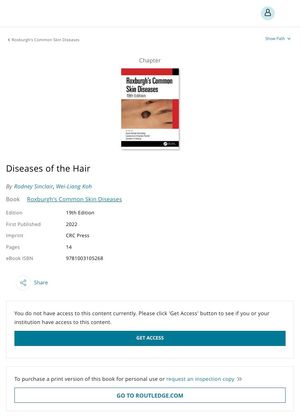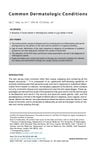Diseases of the Hair
February 2022
in “
CRC Press eBooks
”
hair loss nonscarring alopecia scarring alopecia hypertrichosis hirsutism pseudofolliculitis pro-androgen medications hypothyroidism polycystic ovarian syndrome telogen effluvium Androgenetic Alopecia AGA medical treatment surgical treatment camouflage techniques primary scarring alopecias Graham-Little syndrome lichenoid follicular eruption depilatory measures hair thinning excessive hair growth ingrown hair PCOS hair shedding hair restoration hair transplant hair concealers hair removal

TLDR Hair disorders include hair loss, excessive hair growth, and ingrown hairs, with various treatments available depending on the cause.
Hair disorders encompass hair loss (both nonscarring and scarring alopecias), excessive hair growth (hypertrichosis and hirsutism), and ingrowing hair (pseudofolliculitis). Factors such as pro-androgen medications, hypothyroidism, obesity-related polycystic ovarian syndrome, and incidental telogen effluvium can accelerate hair loss in women. Most patients with Androgenetic Alopecia (AGA) can be treated with a mix of medical, surgical, and camouflage techniques. The document also discusses primary scarring alopecias, including Graham-Little syndrome, which involves patchy scarring alopecia of the scalp, nonscarring loss of axillary and pubic hair, and lichenoid follicular eruption on the body and/or scalp. Investigations can be targeted based on a systemic review of symptoms and signs. Hypertrichosis is classified based on age of onset and extent for considering possible causes. Depilatory measures are beneficial, and treatment should also be directed to the cause.

